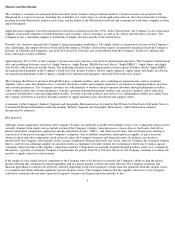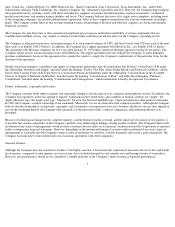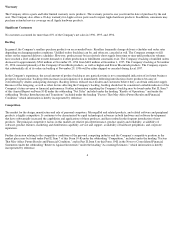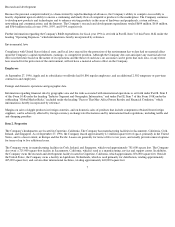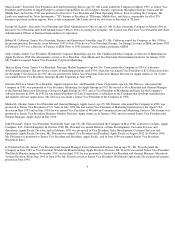Apple 1996 Annual Report Download - page 15
Download and view the complete annual report
Please find page 15 of the 1996 Apple annual report below. You can navigate through the pages in the report by either clicking on the pages listed below, or by using the keyword search tool below to find specific information within the annual report.stimulate demand. The average aggregate revenue per peripheral product was flat during the twelve, nine, and three months ended September
27, 1996 compared with the same periods in 1995. The average revenue per Macintosh and per peripheral unit will remain under significant
downward pressure due to a variety of factors, including industrywide pricing pressures and increased competition.
International net sales represented 52% of net sales in 1996 compared with 48% of net sales in 1995. International net sales trended downward
beginning in the second quarter of 1996, decreasing 3%, 11% and 13% during the twelve, nine, and three months ended September 27, 1996,
respectively, compared with the same periods in 1995. Net sales in European markets trended downward beginning in the second quarter of
1996, decreasing during the twelve, nine, and three months ended September 27, 1996 compared with the same periods in 1995, as a result of a
decrease in Macintosh and peripheral unit sales, partially offset by an increase in the average aggregate revenue per Macintosh and per
peripheral unit, primarily during the first part of the year. Net sales in Japan trended downward beginning in the second quarter of 1996,
decreasing during the twelve, nine, and three months ended September 27, 1996 compared with the same periods in 1995. An increase in
Macintosh unit sales during these periods was more than offset by a decrease in the average aggregate revenue per Macintosh and per
peripheral unit and a decrease in peripheral unit sales. Domestic net sales trended downward beginning in the second quarter of 1996,
decreasing by 18%, 26%, and 30% for the twelve, nine, and three months ended September 27, 1996, respectively, compared with the
corresponding periods in 1995, resulting from a decline or lack of growth in demand for all product families.
According to an industry source, in the fourth quarter of 1996 compared with the fourth quarter of 1995, the Company's share of the worldwide
and U.S. personal computer markets declined to 5.4% from 8.7%, and to 7.3% from 13.2%, respectively.
Net sales increased $1,873 million, or 20%, in 1995 over 1994, primarily due to a combination of unit growth, higher average selling prices,
and changes in currency exchange rates. Total Macintosh computer unit sales increased approximately 15% over the prior year. This unit sales
growth resulted principally from strong sales of the Company's Power Macintosh(registered trademark) products, which accounted for more
than 70% of total unit shipments during the fourth quarter of 1995, compared with 26% in the comparable period of 1994, and from sales of
newer product offerings within the Performa(registered trademark) family of desktop personal computers. This unit growth was partially offset
by declining unit sales of certain of the Company's older product offerings. The average aggregate revenue per Macintosh unit increased 12%
in 1995 compared with 1994, primarily due to a shift in product mix toward the Company's newer products and products with multimedia
configurations.
International net sales represented 48% of net sales in 1995 compared with 46% of net sales in 1994. International net sales grew 25% in 1995
from 1994, primarily reflecting strong net sales growth in the Pacific region, particularly Japan. Domestic net sales increased 16% in 1995 over
1994.
In general, the Company's resellers purchase products on an as-needed basis. Resellers frequently change delivery schedules and order rates
depending on changing market conditions. Unfilled orders ('backlog') can be, and often are, canceled at will. The Company attempts to fill
orders on the requested delivery schedules. However, products may be in relatively short supply from time to time until production volumes
have reached a level sufficient to meet demand or if other production or fulfillment constraints exist. The Company's backlog was
approximately $563 million at November 29, 1996, and consisted primarily of the Company's PowerBook products, as well as higher-end
Power Macintosh products.
In the Company's experience, the actual amount of product backlog at any particular time is not a meaningful indication of its future business
prospects. In particular, backlog often increases in anticipation of or immediately following introduction of new products because of
overordering by dealers anticipating shortages. Backlog often is reduced once dealers and customers believe they can obtain sufficient supply.
Because of the foregoing, as well as other factors affecting the Company's backlog, backlog should not be considered a reliable indicator of the
Company's future revenue or financial performance.
The Company believes that net sales will remain below the level of the prior year's comparable periods through at least the first quarter of
1997, if not later. In addition, there can be no assurance that the Company will be able to achieve sales levels in the first quarter of 1997
comparable to the levels achieved in the fourth quarter of 1996.
13



